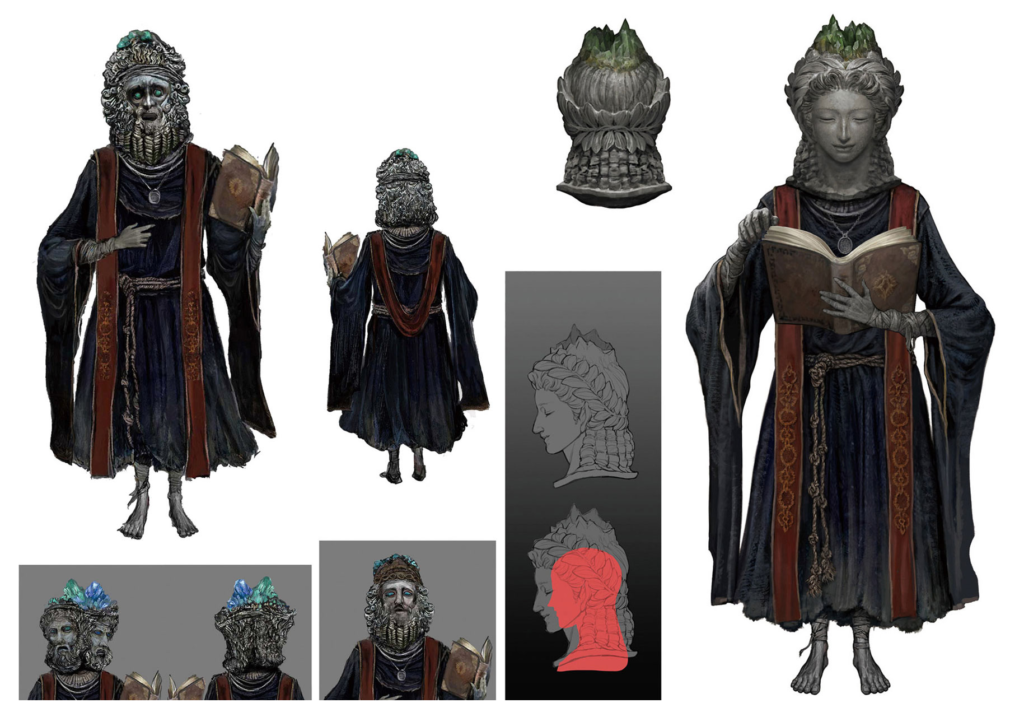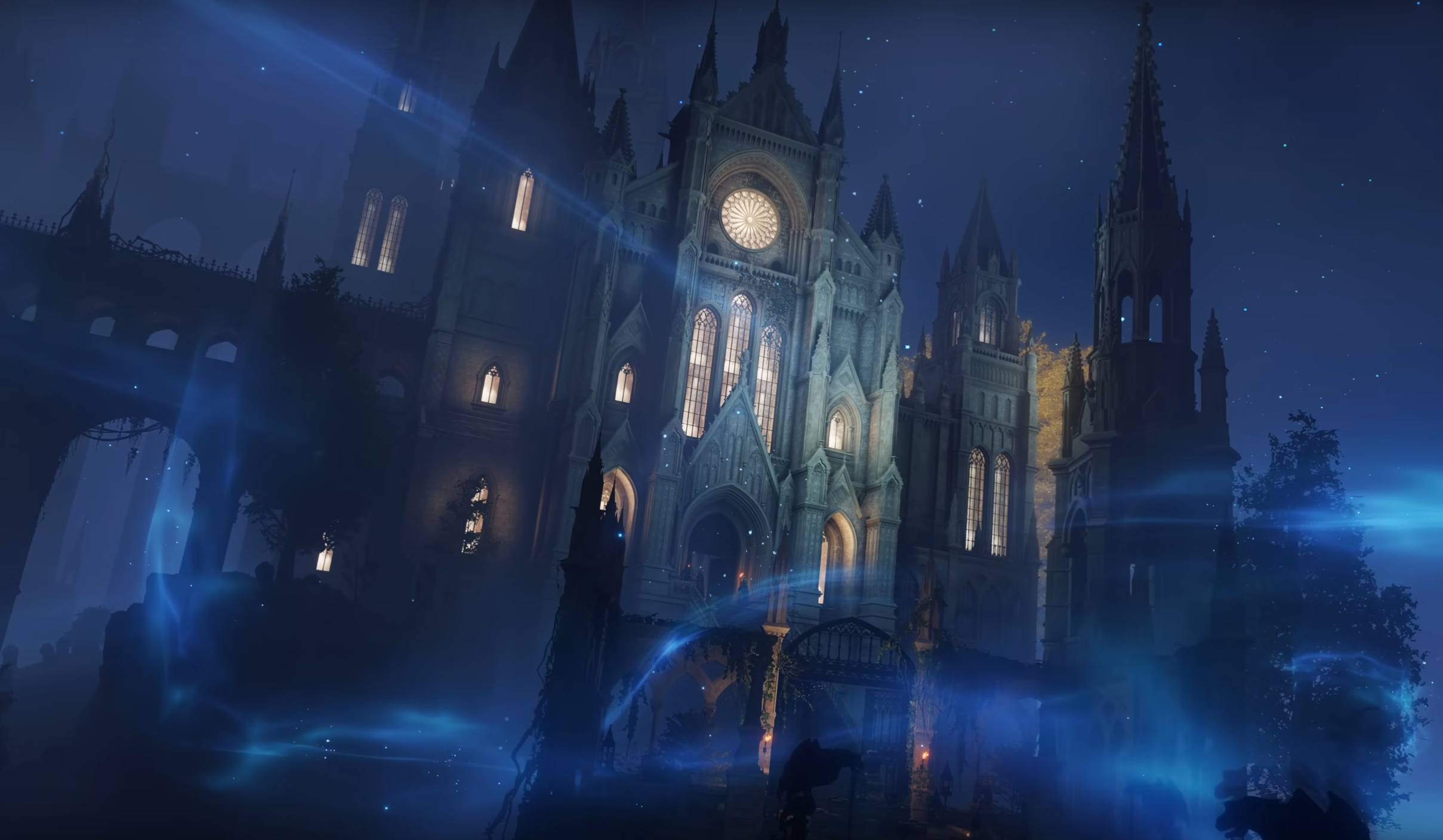Mikael D. Sebag (University of California, Irvine)
The art direction of Elden Ring (FromSoftware, 2022) bears a clear thematic and visual indebtedness to the European Dark Ages (c. 500–1000 CE). Abandoned fortresses and violent, vagabond knights all hint at the postlapsarian collapse of centralized authority at the heart of the setting’s richly developed history. And while (neo)medievalism in fantastic media is often more elastic in its periodization than academe, the magic school of Raya Lucaria nevertheless represents a noteworthy exception to the gameworld’s otherwise Dark Ages aesthetic. Though the school’s High Gothic architecture brings to mind the famous Hogwarts castle of Harry Potter (see Figure 1), Raya Lucaria Academy’s interior is distinctively more early modern in appearance, from the items that furnish its halls to the fashions of its inimical inhabitants. I argue that using the visual language of the Renaissance (c. 1400–1600 CE) in Raya Lucaria reinforces historical narratives that erroneously position the fifteenth and sixteenth centuries as a turning point in the history of learned magic.
But first, the evidence.

There are several key ways that Elden Ring evokes the Renaissance in its depiction of Raya Lucaria Academy. Those who inhabit the school wear academic dress consistent with the English Renaissance, complete with sober black robes, elaborately pleated smocks, and black square-shaped caps (see Figure 2).

Some (Glintstone Sorcerers) also wear stone headwear carved in the semblance of the academy’s founding figures (see Figure 3). These Glintstone Crowns are sculpted in a Greco-Roman style that itself gestures at Renaissance humanism’s interest in reviving and imitating the artforms of classical antiquity. The unique Glintstone Crown of the NPC Sorceress Sellen is further adorned with a stone laurel wreath and curled hair, further alluding to Greek and Roman statuary (see Figure 3 again). Such classical references are infrequent elsewhere in the game.

Within Raya Lucaria, framed oil paintings of the institution’s founding scholars litter and adorn the halls. The practice of secular portraiture in oils in the West is also a largely Renaissance development (West, 2004). Elsewhere, we find tall-backed wooden joined armchairs, similar to the various English styles of chair seen in the sixteenth and seventeenth centuries (Jellinek, 2009). Then there are the many broken armillary spheres that litter the halls and the large tellurion that hangs in the academy’s debate parlor, signifying the school’s emphasis on astrological magic: a practice that enjoyed some renewed interest during the Renaissance.
So why should this matter? Whether deliberate or accidental, associations between early modernity and learned magic resurrect the ghost of a long-dormant historical narrative, the “Yates thesis.” In addition to its larger argument, Frances Yates’s thesis positioned the fifteenth century as a unique turning point in the history of magic, characterized by the emergence of a “new elegant [Renaissance] magic” that replaced the “old dirty magic” of the Middle Ages (Yates, 1964; 80–81). While the Yates thesis has since been persuasively countered (Klaassen, 2013), the visual evocation of a connection between learned magic and the Renaissance in Elden Ring suggests that a similar mental association may have developed in parallel to the Yates thesis—an association that still persists in the popular imagination and perpetuates a distorted view of Western intellectual history.
References
FromSoftware. (2022). Elden Ring (PC Version) . Bandai Namco.
Jellinek, T. (2009). Early British Chairs and Seats. Antique Collectors Club Dist.
Klaassen, F. (2013). The Transformations of Magic: Illicit Learned Magic in the Later Middle Ages and Renaissance. Penn State Press.
West, S. (2004). Portraiture. Oxford University Press.
Yates, F. A. (1964). Giordano Bruno and the Hermetic Tradition. Routledge & K. Paul.

Interesting references, Mikael.
Have you looked into official and extra-official paratexts relating to Elden Ring (artbooks, developer testimonies, tie-ins, fan speculation etc) for further details & context on these aesthetic choices? Some devs really do like to show off their research.
That’s a great question, thank you. This line of research is very much in its infancy, but I did go through both volumes of the Elden Ring Official Art Books from Udon Entertainment and combed Reddit and YouTube for some fascinating fan discussions about Raya Lucaria and its lore. There remains a wealth of interesting similarities between the underlying magical theory of the Glintstone Sorcery studied at the Academia of Raya Lucaria and the theoretical basis of astrological magic in our own world’s history that I’m hoping to explore in some future work as there simply wasn’t room here, and those similarities aren’t always visually invoked in the game. Developer testimonies are something I haven’t had a chance to look at yet, but that’s a great idea, thank you!
Really interesting! Have you seen these influences (namely, a sort of revival or the Yates thesis) similarly incorporated in other games? If so, what would you suspect could be the draw?
This influence is indeed something I’ve detected in other games, like The Elder Scrolls V: Skyrim, Baldur’s Gate 3, the Trine series, and maybe even a little in Genshin Impact from what I can tell (though I’ve yet to play it myself).
I believe there’s two things happening here, potentially. One is that an extended view of the Renaissance includes the astronomical (and medical/chemical) developments of the Scientific Revolution, famously with Copernicus, Kepler, and Galileo, so astrolabes, armillary spheres, and orreries are seemingly abundant in wizardly locales and institutions (along with alembics, phials, furnaces, and other alchemical paraphernalia). Second is that because magic often functions as a surrogate for modern technology in fantasy settings (providing telecommunications, fast travel, portable light, etc.), it makes sense that Renaissance science—particularly astronomy and chemistry in the form of alchemy—would thematically signal a kind of practical, technoscientific knowledge.
The entanglement of magical learning and scientific experimentation that we see in medievalist fantasy worlds invokes Yates’s assertions that these two were tightly imbricated developments in early modernity (and they were), but fantasy worlds typically invert the relationship somewhat, where magic becomes the more ubiquitous and ontologically legitimate of the two disciplines. Science and magic both pursue mastery of the natural world, but, in fantasy, magic is the tradition that largely succeeds in doing so.
Fascinating overview! To add onto Vinicius’ question slightly, do you know if there’s anything in the game’s narrative choices (item descriptions, NPC dialogue etc…) which might show these aesthetic choices being taken further into the way Raya Lucaria’s Academy has been integrated into the wider world of the Lands Between?
That’s a really good question, and it’s one that I’m almost certainly not yet as prepared to answer as comprehensively as I’d like! I’m also happy to follow up if I’ve misunderstood your question.
One thing that I wanted to bring up in the paper—but didn’t have the space for—was the insignia associated with using Glintstone sorcery. There are different on-screen symbols for different traditions of magic, and whenever a player casts a Glintstone sorcery spell, the heraldic crest of Raya Lucaria briefly appears overhead before winking out of existence. Through screen captures and data mining, fans have pulled out all of these images and analyzed the symbolism within them (there’s a few YouTube videos on this, if you’re interested in learning more).
Speaking again to the Renaissance-style art direction of Raya Lucaria, what’s fascinating to see is that the insignia for Glintstone sorceries and the closely related Carian/Crystallian and Night/Bubble sorceries are all similarly styled like early modern bookplates. This aesthetic similarity reinforces the narrative relationships between Raya Lucaria’s focus on Glintstone sorcery, its connection to the Carian royal family, its reverence for the Crystallians, and the similar academic approach to magic shared by Raya Lucaria and the practitioners of Night sorcery in Sellia, Town of Sorcery. Meanwhile, with a few exceptions, other sorceries and incantations are distinctly more Celtic and tribal (as in the tattoo style) in appearance.
As for NPC dialogue and item and spell descriptions, that’s something I still need to look at more closely because there is such a wealth of information to be stitched together, and it’s hard to find something in the lore that the player base hasn’t already dissected when it comes to a game such a dedicated fans.
[…] Renaissance Magic Against a Medieval World: An Art-Historical Reading of Elden Ring’s Raya Lucaria… – Mikael D. Sebag (University of California, […]